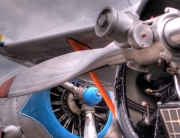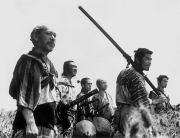I still remember laughing heartily at a small skit by the comedian Eddie Izzard. He was trying to describe his first experience as a small airplane charter client. I think the best part was when he explained in detail the small airplane, small cabin, and the single pilot who was giving a safety briefing over the Public Address system (like in an airline) while Eddie was so close behind him he could touch him. Oh, and did I mention the pot of coffee for copilot? (You can find the skit on YouTube for your viewing pleasure… search for “Volskwagen with Wings, by Eddie Izzard”).
Needless to say, whether the passengers are sitting right behind you or 25 feet away, they are still very much a part of your flying environment and responsibilities. Same goes for flight attendants, or, in the aero-medical world, Paramedics. I think of all the professional pilots out there, only cargo dogs have the perks of a passenger-free care. But there are still many other people and factors that pilots have to deal with outside the cockpit. In general, most of the information relating to those factors can be found in the Company Operations Manual. Although it is a gem of information, it often lacks in covering some operational basics, especially when it comes down to the communication methods or channels outside of the pilot hierarchy.
The most obvious and constant channel of communication is with ATC. While they may not be sitting in the aircraft, Air Traffic Control has just as much to say as you do when flying in high-density airspace, and a tight, precise communication with them is key to safety. Many accidents can be found in the archives of aviation history where miscommunication with ATC has led to unnecessary accidents and fatalities. Just remember, they are part of the team. One thing that I remember from my IFR ground school as a young pilot pup was that ATC is there to help you. Don’t be afraid to ask for a different route, altitude, etc. Just make sure that you let them know what you have in mind and they will most likely try to help you out.
Another common factor that pilots have to deal with are passengers. If you are flying for a major airlines, passengers tend to create much less of a pressure than when they are up close and personal on charter flights. In this particular area some pilots (like me) have been fairly lucky and never had to deal with the pressure that a demanding charter client can put on the pilot. However, I think that if you do find yourself in a tight spot with a demanding passenger, the best is to simply distance yourself as well you can. Weather, mechanical failures and other similar things are – despite what your experienced backseat passenger might tell you – items that should be careful reviewed and dealt with before departing. I remember a story where, during my first summer as a First Officer, we found out that 2 massive lines of thunderstorms were blocking our way home. Despite their different agendas and plans, the 8 passengers that we had accepted very happily the decision of staying an extra night to wait the storm out after being explained the problem and consequences of trying to mingle with a solid line of CB clouds. Some pilots have been less fortunate. I recall a story heard in flight school of a crew of a corporate jet crashing short of their destination airport after being pressured into flying by their passengers, who threatened to report the crew and get them fired if they didn’t take them to their very important dinner meeting. Well I’ll tell you what: when it comes down to your dinner meeting, your ski vacation or me going back home alive… I’ll never even blink when I turn down the trip.
Finally comes the last culprits… If you are in the Aero-Medical world, we call them Medics 🙂 If you are a commercial airline pilot, they are generally called Flight Attendants. I think the general problem I have is not directly with those fine, professional individuals but mostly with the innadequate preparation and training involved in dealing with their side of the world. As part of the aero-medical community at the moment, I have seen first-hand the lack of material presented in the CRM and Human Factors part of the ground school relating to dealing with the stress of medical emergencies. It is one thing to remain professional and detached while simply checking weather, but I often feel inadequate when I am faced with the task of transporting a really sick kid, and my human nature is struggling so hard to take over my professional training (see a related article, http://jdmarcellin.wordpress.com/2010/08/23/taking-the-passion-out-of-compassion/). So where did we lose the big picture? And most importantly, what can be done to help the cockpit crews and the cabin crews work better and more efficiently? Segregation or Collaboration?
In my personal opinion, segregation has been tried many times already – and with poor results, whether its in the medical or commercial sides of aviation. As well as creating a rift between the people themselves, it creates a barrier that often causes frustration and anger over the lack of communication mainly. Even if segregation might seem a good idea, it’s no more than a simple “band-aid”, there only to act as a quick fix. No more talking or interaction with the crews in the back means no more stress related to outside-of-the-cockpit elements, right? Not so simple! In the medical world, pilots are still very much exposed to the nature of the medical emergency they are dealing with and whether they want it or not, are affected by it in some degree or another. In the commercial world, whether you’re dealing with a beligerent passenger or catering problem, you are still part of the equation and often, the solution.
So collaboration seems to be the logical solution. But despite the seemingly simple nature of the word, it still remains intricate in the ramifications involved. I know that bigger airlines often have part of their training dedicated to preparing their cockpit crews for these sort of events, but the smaller companies often stick with the bare minimum required by the transport authorities. This leads to a lot of misunderstandings and problems that could be resolved if we were trained and prepared to deal with the basics of the pilots/medics dynamics. Maybe a review of the ground school programs could help foster a better working environment by providing the pilots with the tools to effectively communicate with their back-seat counter parts.
Now, you have probably caught my drift… after a thousand words, if you should only remember one, it is this one: Communicate. That word alone is a life saver. Literally!
____________________________________________________
(If you have not had the chance to do so yet, please feel free to read the intro and part 1 of this article)
Chuck Yeager and You – Or the Human Factor (Intro)
Chuck Yeager and You – Or the Human Factor (Part 1 – CRM in the cockpit)



[…] Chuck Yeager and You – Or the Human Factor (Part 2 – CRM outside the Cockpit) […]
Normally I don’t read post on blogs, but I would like to say that this write-up very forced me to take a look at and do it! Your writing style has been amazed me. Thanks, quite nice article.
Thank you so much! I truly appreciate your kind words and hope that you can find interest and maybe a few words of wisdom in the other posts as well. Cheers!